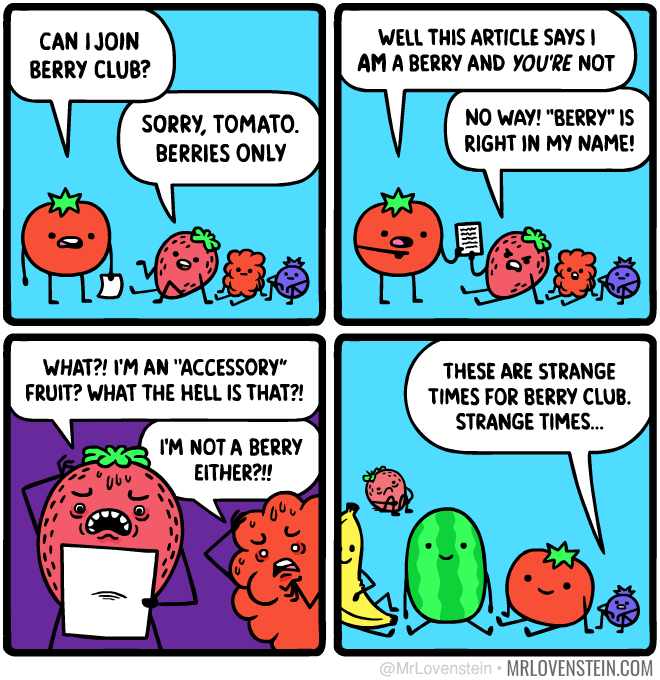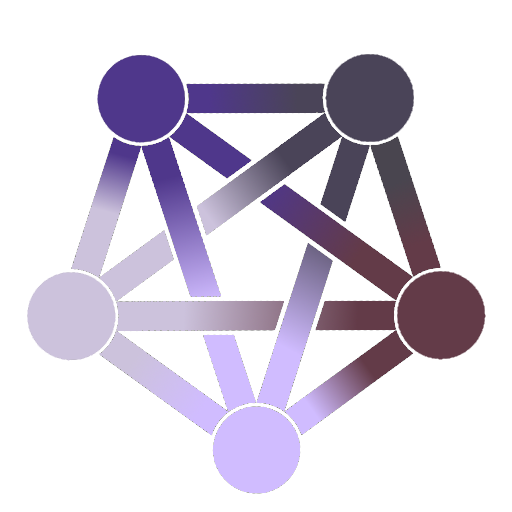The whole fruit/vegetable controversy only comes because we’re trying to use two different domains of terms interchangeably: botanical terms and culinary terms.
Tomatoes (and squash, and pumpkins (which, side note, are a type of squash), and cucumbers) are botanically fruits, but culinarily they’re most commonly used as vegetables because they tend to be less sweet, particularly when raw. Mushrooms are botanically…well, I guess they’re botanically “n/a”, as they’re not a part of the plantae kingdom, but whatever–they’re typically considered botanical, so they’re “botanically” fungi, but culinarily they’re most commonly used as vegetables (or, interestingly, as meat replacements).
We get into the same linguistic confusion when we start throwing around “peanuts aren’t nuts, they’re legumes!”–botanically, yes, peanuts are legumes, but culinarily they’re most commonly used as nuts. See also: “green beans” are botanically pods, not beans, but we use them culinarily as vegetables; and many “berries” are botanically something else but we use them culinarily as berries; meaning they’re often left whole, mixed with other berries in the same dish, and go well with cream in cold summer desserts.
The whole thing is a misguided exercise in pedantry; “technically burritos aren’t sandwiches, they’re meat-sacks!” They’re both, and we instinctively understand that trying to compare the two terms is silly because “sandwich” is a culinary term and “sack” is not.
Another funny part of this is that pedants are trying to say that tomatoes are (botanically) fruits and not vegetables, but the closest thing to a definition we have for “vegetable” botanically is “literally all plant life and maybe also some fungi,” so tomatoes are clearly both fruit and vegetable botanically.Plus, they’re culinarily used as vegetables, but can also be used as fruits in some cakes, pies, sorbets, and so forth (and isn’t ketchup just a tomato smoothie?), so tomatoes are clearly both fruit and vegetable in culinary terms as well.edit: Someone who actually knows what they’re talking about (an ecologist) has corrected my botanical definition of “vegetable.” Actually, they’re “edible parts of a plant which are not fruit.” Which means that tomatoes are explicitly excluded as vegetables, being botanically a fruit. I don’t think that ruins my overall point in any way, though.
good post, sounds like a copypasta
Alas, it’s all me. I…tend to be a bit verbose.
Oh–and thanks! I think that’s praise, at least.
I mean it in a most sincere and endearing way. Gave me a joy and chuckle.
Excellent to hear. That’s what I was hoping for!
Great post, with one caveat
the closest thing to a definition we have for “vegetable” botanically is “literally all plant life and maybe also some fungi,”
I got my degree in Ecology and Evolution, and we always used a similar working definition but it was “edible parts of a plant which are not fruit.” So basically botanically, stems, roots, leaves, flowers, and all subvarieties of those are vegetables. Fruits are fruits. Fungi are fungi.
I always heard that biologically vegetables doesn’t exist. Everything is fruit. (Except grain, flowers, the obvious)
So what are potatoes? That just a tuberculo.
Carrot? Just a root. Yes it’s edible to humans but biologists don’t really care because everything is edible to something.
Disclaimer: not a biologist, just a dude tired of people violently interrupting me to tell me that “akschually a strawberry is a nut!!!”
Yes, you’re correct but that’s why I said it was a “working” definition. When you’re a botanist (like many of my former professors) you still use the word vegetable in discussion. They would often teach us about local plants with indigenous uses using plain language like “the Chumash used the leaves of this plant as an important part of their vegetable intake”, rather than using some clinical term like “edible plant matter” or whatever.
I was only saying in these contexts, they definitely wouldn’t describe fruits as vegetables because fruit are a specific thing to a botanist. They definitely wouldn’t describe fungi as vegetables because they are also a specific thing to a botanist (not relevant 😂)
So in a scientific setting the word vegetable is still used, but it is mostly defined by what it’s not!
But when you translate “vegetable intake” to my language Danish it will have a totally different meaning. I am assuming that it means eating plant matter as you mention. I am wondering if it is a similar challenge in other languages. Because “grøntsag” will not be leaves of some tree in the Amazon, or tobacco, or a edible cactus.
It will just refer to that part that kids never eat from their dinner plate.
I guess there is a reason why it is not a very scientific language 😅
Awesome, thank you for the correction. I appreciate your expert review!
It is a bit weird that we use some fruits as “vegetables”, like tomatoes and cucumbers. But, other fruits like mango or raspberry are so different from your typical “culinary vegetable” that you have to be very careful in how you use it in a savoury dish. There isn’t the same crossover for other edible plants. For example, I can’t think of any tuber that could sneak into a fruit salad unnoticed.
I guess it comes down to there being a lot more variety among fruits than other edible plant parts. Plus, humans have been tweaking edible plants for millennia. So, who knows, maybe the original cucumber was more “fruity”, but has been tuned over the years to be more “saladey”.
Definitely interesting. I wonder if there might also be a little bit to the fact that botanical fruits are basically just the best way to house seeds so that they’ll have some energy to grow when planted, which means that it’s independently evolved in a lot of different plants; so the culinary diversity of “fruits” is much greater.
Yeah, that seems likely to me too. Especially because some fruits are designed to appeal to animals who will eat the fruit and then poop out the seeds somewhere, and different fruits will appeal to different animals. A fruit “designed” to be spread by birds will be different to one “designed” to be spread by a hippo.
For example, I can’t think of any tuber that could sneak into a fruit salad unnoticed.
It’s not whole, but I can definitely imagine tapioca being used to thicken the juice for a fruit salad, and that comes from cassava, a tuber.
For example, I can’t think of any tuber that could sneak into a fruit salad unnoticed.
Some sweet potatoes can be very sweet indeed, and they can be used in sweet dishes too (I’ve seen for example, sweet potato mash topped with marshmallows). They are just too porous to be used in a traditional fruit salad.
I guess it comes down to there being a lot more variety among fruits than other edible plant parts.
Pulses are incredibly variable too in their usage. You can use them as nuts, vegetables, grains, oil or pastes (sweet and savoury). You can use them in place of potatoes, you can bake bread from them, you can even use them to replace meat in many situations. Young sweet peas can be used almost in place of some fruit as well.
So, who knows, maybe the original cucumber was more “fruity”, but has been tuned over the years to be more “saladey”.
Cucumbers are a kind of pumpkin, same as melons. They are all variations of the same original fruit, and yes, some of them are clearly in fruit-salad territory, while others are more saladey and others again can be used in place of potatoes.
And lastly, the most crazy variable plant is Brassica. Different cultivars of this one plant provide swede, turnip, kohlrabi, cabbage, collard, kale, cauliflower, broccoli, romanesco, Brussels sprouts, mustard seed, rape seed and a lot of smaller, lesser known things too.
Some sweet potatoes can be very sweet
Yeah, there are sweet tubers. But, you can’t put a raw piece of sweet potato in a fruit salad. If you cooked it to bring out the sweetness it would be as sweet as the fruit in the salad, but it would stand out for being very mushy.
Pulses are incredibly variable too in their usage.
I haven’t heard the term “pulse” before, I’ve heard “legumes”. But, yeah, that group has a lot of variety. Red beans are frequently used as a sweet filling in east Asian cooking, chickpeas as crunchy snacks, etc.
It’s more an issue of consistency than of taste though with sweet potatoes. There are some fruits that also don’t fit into a fruit salad for similar reasons, like e.g. passion fruit or very soft kinds of nectrarines.
But I have seen ginger in fruit salad before.
Like, a big knob of ginger? Or just ginger shavings?
Jicama would be quite good in fruit salad.
I could see water chestnuts in a fruit salad, although they’re technically corms, not tubers.
Fun facts, in French vegetables are called “legumes”, even though most of them aren’t related to the Fabaceae family
I’m so glad that this problem isn’t just limited to English.
Spanish doesn’t have a word for nuts, they just say “dried fruit”.
What do they call actual dried fruit?
I mean they’re not really that different, right?
Yeah, I’d say they’re really different.
Haha me too… I mean a coconut is not really ‘dry’?
ceci n’est pas drole
ceci n’est pas drole
Would anyone actually use the term Soupe aux légumineuses or just be direct about what’s in it?
Another similar thing is the definition of ripe.
A fruit can be ripe for consumption (culinary ripeness), and it can be ripe for seed-bearing (botanical ripeness). You can see the difference with cucumbers, which are ripe for eating when they are green and the seeds are barely developed, while they are close to inedible when ripe for seed-bearing. Then they will turn yellow, the pulp shrinks down and becomes slimy and the seeds become big and hard.
Oh dang, I hadn’t even considered that! I wonder if that’s the same across all fruits we tend to eat raw.
No, most are actually at their best when the seeds are ripe too, but there are others where culinary ripeness doesn’t equal seed ripeness, like e.g.green bell peppers.
Ah, once again, nature refuses to be easily categorized! Thanks.
I am 100% with your well written explanation here!
Just one ‘nitpick’, that isn’t really even a nitpick because you did qualify the relevant part with ‘tend to be’:
A properly grown tomato absolutely can be so flavorful, sweet, tangy, varied, complex… that you could just eat it like an apple.
Not as sweet as most apples, but way, way more sweet than the typical mass produced tomato you’re likely to get in the US.
I’ve been to a few farmers markets where… a couple of smaller farms were growing just absolutely stellar quality tomatoes.
…
On the other hand, squash and zucchini, even the fancy ones from farmers markets?
Main difference I noticed was basically perfect ripeness, they still just taste like nothing.
(I guess I should also point out this was from 10ish years back, sadly, a lot of farmers markets now have a lot of people basically just reselling some particular, slightly higher quality but still mass produced fruits and veggies, than aren’t even local)
…
Finally, to throw more insanity on this terminology dumpster fire…
Corn.
Corn is arguably, from different domains of technical or colloquial meaning… a fruit, vegetable, and grain.
After millennia of us artifically selecting (and then just outright genetically engineering) what was originally, basically a kind of grass, we now have something that is now so sweet, that the US uses it to make HFCS, a cane sugar substitute… and then we jam that HFCS … into bread, soda, everything.
So… ketchup… is then roughly a tomato/corn smoothie, made primarily from two… frui-getables.
Yep.
Fruigetable.
(froojzh-tah-bull)
((im too lazy to look up IPA symbols))
You’re welcome, bwahahah!
Thank you! Glad you enjoyed it.
A properly grown tomato absolutely can be so flavorful, sweet, tangy, varied, complex… that you could just eat it like an apple.
I am sad to say that, although I’ve heard of this, I have never had the pleasure of eating such a tomato.
Finally, to throw more insanity on this terminology dumpster fire…
Corn.
As a native son of Indiana, I have to say that’s the thing that breaks pretty much all of my categories. I lived the first twenty years of my life thinking that it qualified nutritionally (ugh, that’s another part of this terminology dumpster fire…the food pyramid. shudder) as a vegetable, which it…doesn’t really.
So… ketchup… is then roughly a tomato/corn smoothie, made primarily from two… frui-getables.
Great point. “Tomato smoothie” is already a term that makes me feel a little bit queasy, but adding in the corn…
Fruigetable.
Beautiful. fɹud͡ʒ.tə.bəl, I think, incidentally.
Beautiful. fɹud͡ʒ.tə.bəl, I think, incidentally.
That seems right to me, the… what is that a lower case sigma?
iirc, thats the sort of… rolling ‘zh’ sound I was going for…
… though I think maybe we just have a natural dialect difference for how how to pronounce vegetable, as you’ve got the same vowel sound for the last two syllables?
But anyway, yeah, I think I came up with ‘fruigtable’ almost 20 years ago, upon first learning how much overlap there is due to all this linguistic silliness… so i choose chaos, and decided to add to it, and now I finally have a relevant time to use the nonsense/compound word, woo!
I only have the most pedestrian understanding of the IPA from a single class in college (which was a long time ago), so I’ll admit I just grabbed the IPA off of Wiktionary for “fruit,” “vegetable,” and “fudge” to bridge between the two. It looks good enough to my eyes to be at least reasonable.
i can totally eat small flavourful tomatoes on their own, but something about the idea of biting into a larger tomato feels very unsettling to me, i think it’s the amount of loose slimy flesh around the seeds?
when the tomatoes are small enough they’re just berries, which works fine
I completely agree with 99% of bigger tomatoes, but… I evidently just cannot forget those few, exceptionally good heirloom tomatoes somebody had grown back in the PNW a decade ago, hah!
Could be worse, don’t take a bite out a … tomacco.
And as far as the vast majority of people are concerned, the culinary definition is the one that’s actually relevant for them.
You must be fun at parties.
I am actually…kind of just like this at parties. So, you be the judge.
Tumblr is the neo-positivist/neo-berkeleyianism hivemind as a result from the inoculation by western STEM ideology. They love their AKSHUALLY WOW MINDBLOWN spiel.
The crucial difference is that the culinary classifications have no scientific basis.
the closest thing to a definition
we“we” have for“vegetable”vegetable botanicallyWho is “we”? People (ITT) who study botany have functional, scientific definitions.
The culinary classifications have no scientific basis, but they do have an anthropological basis. They’re not completely meaningless.
Who is “we”?
I was basing that on a misunderstanding: I thought that the word “vegetation” being an archaic term meant that it was no longer used, but yeah, I was incorrect there. I appreciate the correction.

The true misconception is that there are scientific definitions and culinary definitions. No the culinary definitions don’t fit their scientific category. They’re not intended to.
Strawberries, blackberries, mulberries, and raspberries are not berries.
Bananas, aubergine (eggplants), oranges and grapes are berries.
Dangleberries aren’t real berries either.


I have the last pane spoken with an old man voice living in my head rent free for some reason
It’s alarming the rate at which it just pops up
maybe start demanding rent from the old man living in your head
He told me to get off his lawn and he’s keeping the ball.
It’s almost as if excluding due to arbitrarily drawn lines is a bad idea. It helps nothing, it only serves to hurt
peoplefood.
Pretty sure pumpkins are berries.
what are strawberries and blackberries
strawberries are accessory fruits, blackberries are basically a bunch of fruits holding hands
They’re (mushrooms) also constantly listed on American menus as a “protein” option despite a dire lack of the stuff
Hmm, is it really that little? The stats look devastating, like e.g. 3 grams per 100 grams, but mushrooms also consist out of 90+ grams of water.
For example, the button mushroom has:
100 g total - 91.8 g water - 1.7 g fiber = 6.5g nutrients
2.89 g protein / 6.5 g nutrients = 44.4% proteinComparing that to e.g. canned black beans:
100 g total - 70.8 g water - 6.69 g fiber = 22.51 g nutrients
6.91 g protein / 22.51 g nutrients = 30.9% proteinYes but you don’t dehydrate the food. And you’re not eating multiple kgs of mushrooms in a single sitting, which you would need to get anywhere close to the total amount of protein in other ‘protein’ options
Yes but you don’t dehydrate the food
You kinda do unless you eat then raw. Cooking removes water content.
Cooked beef has 26-35 grams of protein per 100g. Uncooked like 20, and beef doesn’t contain as much water as mushrooms do.
I’d say it’s acceptable to have them in the high protein part, as macro-wise, they are.
That’s a neat site, and I was hoping your answer was in there, but they don’t have data on cooked mushrooms. We’ll have to do a bit of math.
So you’re taking the nutritional data provided and then shunting the fiber and water out of the way. Why? You can’t just eat the nutritional parts of food; you have to eat the whole thing, and that limits the amount of food, and thus nutrition, you can ingest in a day.
Were you thinking about food prep? Some water weight is lost there, certainly, but it’s not everything.
Let’s add a raw steak into the mix, and then we can instead look at how much water weight is actually lost when you prep these things to eat, by estimating it from data elsewhere.
The beans are ready to eat. They’re drained and rinsed. You don’t remove that water weight. So that’s 7 grams of protein per 100 gram serving.
The steak will lose about 25% of its weight when cooked, per multiple sources I found during a search. That means we need about 133 grams of raw beef to achieve 100 grams of cooked beef. So we can multiply its 21 grams of protein by 1.33, and we get about 29 grams of protein in a 100 gram serving. Their grilled steak averages around the same amount, so we’re on track so far.
Why is that discrepancy so great? I thought beans were supposed to be a great replacement for meat?
That comparison was done between beef and dry beans (note the 24 grams of protein, about the same as the beef). 100 grams of dry beans becomes about 370 grams of prepared beans. So in a 100 gram serving of beans you can actually eat, you get just over a quarter of that 24 grams protein: our ~7 grams from earlier. You also lose some water soluble protein when you rinse and drain them. They’re not the magic protein replacement people think they are.
Mushrooms are even worse. Per America’s Test Kitchen (and we’re gonna have to take these numbers at face value because I can’t find anything else), shiitake mushrooms lose about 14% of their weight in water when cooked, and cremini (think portobello, they’re just different stages of development) mushrooms lose about 60%. Thankfully the USDA’s site also has nutritional data listed for these two types of mushrooms: “minimally processed” shiitake and cremini mushrooms contain 2.4 and 3.1 grams of protein, respectively, per 100 gram serving. But those aren’t meal ready. To do that, we’ll cook the mushrooms, and they’ll shrink to 86 gram and 40 gram servings. So let’s start with enough raw mushrooms—119 grams of shiitake (or 119% of the original serving) and 250 grams (250%) of cremini. Multiply our proteins by 1.19 and 2.5 and we get a plausible range of between 3 and 8 grams of protein per 100g serving. So some are comparable to beans in their protein content! And some contain half, or less, of an already low amount when compared to the protein found in meat.
This quick comparison on Wolfram Alpha shows a similar story, with a less optimistic look at mushrooms’ possible protein content. Screenshot:

Now, the fact that you’re taking in so much more water when you eat 100 grams of beans or mushrooms than you are when you eat meat means you can eat more of them, and drink less fluids, but only to a point. And you’re certainly not getting 8 times more mushrooms than beef from a restaurant when they do a protein substitution. Getting enough protein in a vegetarian or vegan diet can be hard work. And restaurants are not making it easier by misleading people who may not know any better—I’m certain it’s careless, not malicious, but it is happening either way.
they don’t have data on cooked mushrooms.
Probably because there are many ways to cook a mushroom. For example dehydration would apparently increase the protein per unit.
All the protein figures you have been using for the calculations have been crude protein, i.e. a estimate based on nitrogen content.
It’s much better to use DIAAS as a measure of usable protein.
https://en.m.wikipedia.org/wiki/Digestible_Indispensable_Amino_Acid_Score
Also a neat site. It seems like the ratio of usable protein would be a good addition to, but a lacking substitute for, the raw quantities. Especially given how incomplete the PCDAAS and DIAAS datasets are.
TIL that I been deceived my entire life.
I’ve anyway severe doubts that most American food really is food
That’s because Vegetable is not a Botanical Term. It is a culinary term. So, Tomatoes are both fruit and vegetable.
This.
All fruits are vegetables. Not all vegetables are fruit.
The definition of a vegetable is just any edible part of a plant. While a fruit is specifically the seed-bearing ovary of a flowering plant.
I don’t think you can just use two classification systems in the same sentence. It should probably be illegal or something
Is that like an official definition for vegetables from some government? Because I don’t feel like there is a particularly good definition of vegetables. People mostly wouldn’t refer to apples as vegetables, for example.
Vegetables are edible parts of plants that are consumed by humans or other animals as food. This original meaning is still commonly used, and is applied to plants collectively to refer to all edible plant matter, including flowers, fruits, stems, leaves, roots, and seeds. An alternative definition is applied somewhat arbitrarily, often by culinary and cultural tradition; it may include savoury fruits such as tomatoes and courgettes, flowers such as broccoli, and seeds such as pulses, but exclude foods derived from some plants that are fruits, flowers, nuts, and cereal grains.
I wouldn’t call all cars a Honda Accord, either, but all Honda Accords are still cars.
The analogy doesn’t work. The apple is the narrow group, while vegetables are the wide group.
To make your analogy fit to the original statement it would be: “People mostly wouldn’t refer to a Honda Accord as a car”. Which is the opposite of what you are saying and it’s also not true, so it really doesn’t make any sense.
The actual issue at hand is that there are two definitions of the word vegetable. One is the wider meaning, where all edible parts of plants are vegetables (and then apples clearly are vegetables), while there’s the culinary definition of vegetables, where vegetables are savoury edible parts of plants, and under that definition apples are not vegetables.
You use the broader definition, while @Ephera@lemmy.ml is using the culinary definition.
“Fruiting bodies,” even
Fungi only got its own kingdom in 1969, before that they were a phylum in Plantae. There are tons of people still around who learned “mushrooms are plants” in school, so it’s not surprising downstream vocabulary hasn’t caught up.
Idk that food vernacular is necessarily downstream of rigorous taxonomies at all lol.
Fair point haha.
They have properties from plants but also from animals, it’s an independent evolution from both.
I don’t think I’ve ever considered a mushroom a vegetable, they’re just mushrooms
maybe if it’s a really dreadfully woody bolete
I believe, that’s mostly a US thing, where the government classifies them as vegetables…
deleted by creator
Yeah but a mushroom’s such a fungi to be with.
He’s such a fun guy that there’s not mushroom to party.
anybody know any other mushroom puns i want free upvotes
This is neither shitposti nor shiitake
Leave mycelium alone
Why is it yourcelium
It’s everybody’s celium. Mycelium. Yourcelium. Ourcelium.
It’s ourcelium komrad
Better check your privilegelium
Big Mushroom is going to take out OP, Boeing-style.
They’re going to fly a holding pattern over his house until one of the doors inevitably falls off?
Actually, “mushrooms are technically meat” is a new hill I’d like to die on. Mushrooms have animal cells, ergo, definitely not a vegetable.
They don’t, they’re a distinct third thing with a distinct third type of cells

They are, however, more closely related to us animals than they are to plants. As in, our last common ancestor is less far back.
Also, unrelated to your comment, but related to the post: vegetable isn’t a botanical term, but a culinary term. So, there’s no bioligical basis for vegetable in the first place, so there’s no issue with counting mushrooms among them. Sure, it’s a bit inconvenient that the word ‘fruit’ is both a culinary and a botanical term in English, and there’s overlap to it, but that doesn’t mean it’s somehow illogical that some things are culinarilu fruits but not botanically, and vice versa.
So, there’s no bioligical basis for vegetable in the first place
idk if I would go that far, I think “edible parts of plants” is a solid foundation. Sure, “edible” is kind of a social construct, but the plant part is indisputable. “Vegetarian” and “plant based diet” are near synonymous
Maybe non-animal is better than just plant, since mushrooms are part of plant based diets.
I’ve never been under the impression that any edible plant part is a vegetable. Like, an almond? An apple? Rice? Cinnamon? I could go on. All edible plant parts. I’ve never heard of them be referred to as vegetables.
What do you mean?
Let’s not forget that apples, strawberries and cashews are pseudofruits, just like the produce of my labor!
Sure, but they are fun guys!
Tomatoes are fun guys indeed.
lol, very good.
Fun-gu(y)s



























